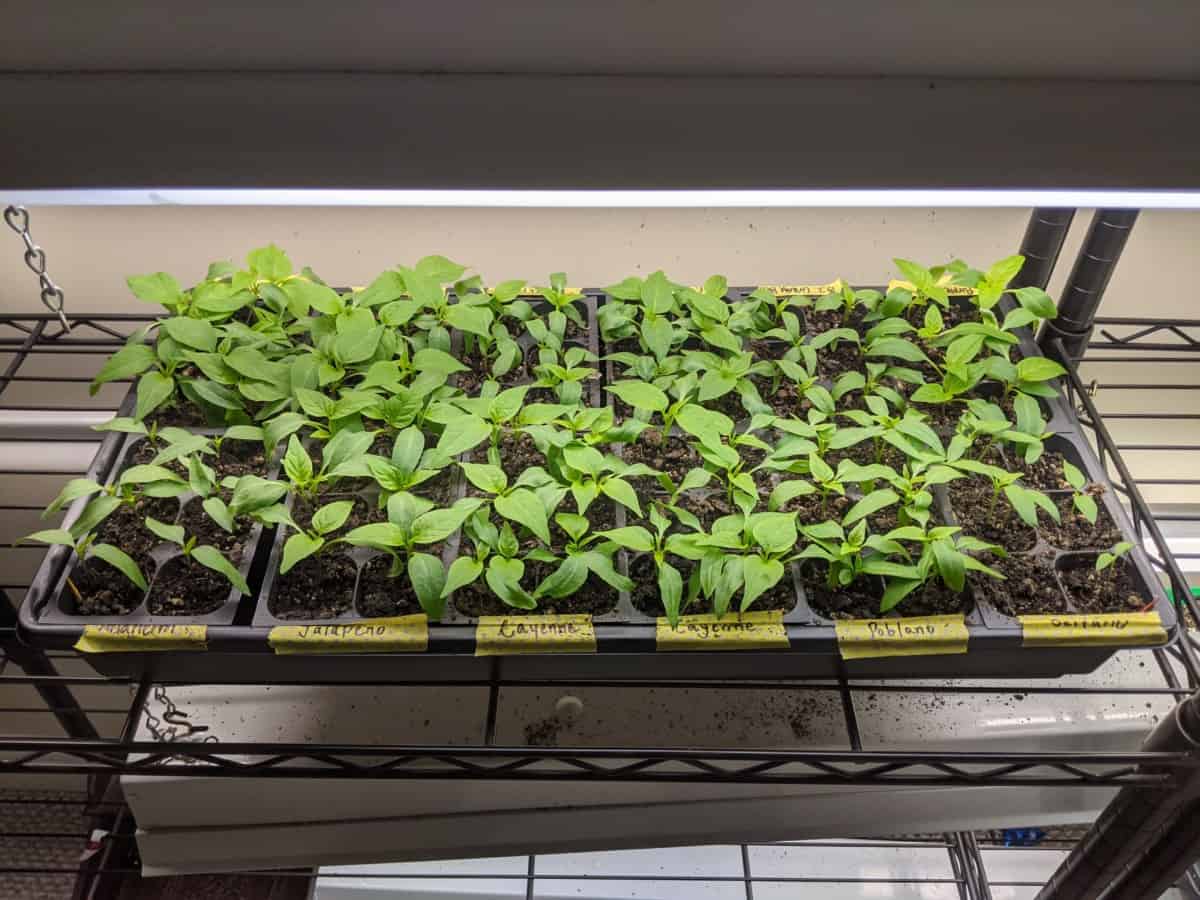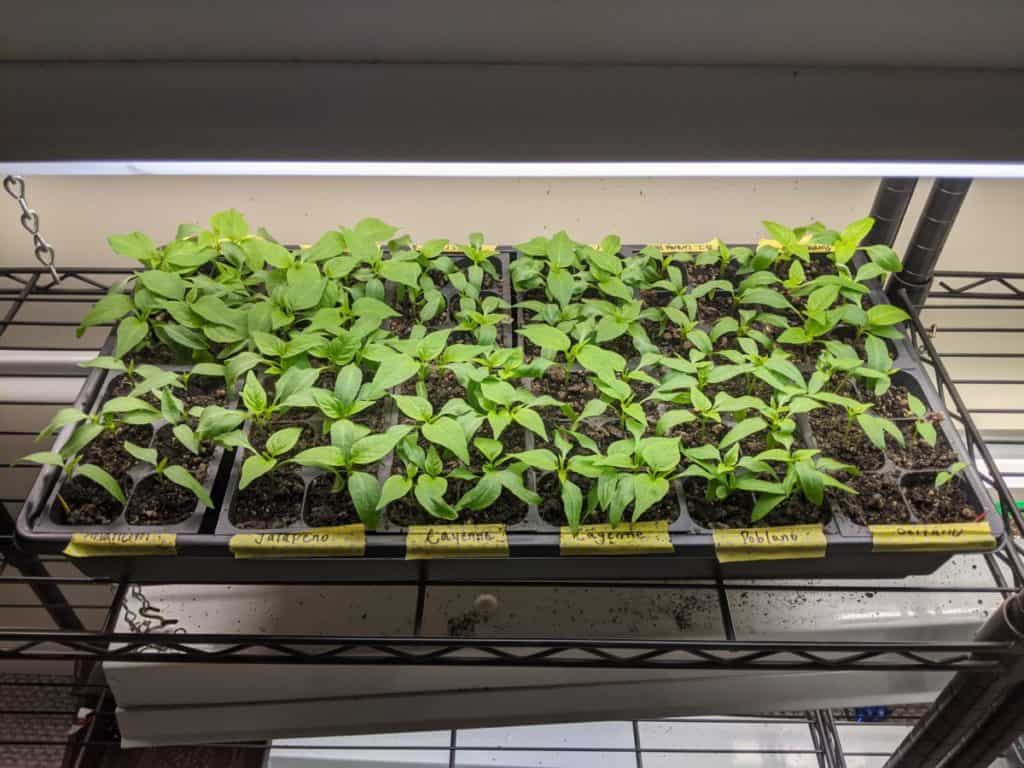
My husband and I have been starting pepper seeds indoors for years. We have grown also sorts of peppers, including cayenne peppers, jalapeños, Carolina reapers, bell peppers, ghost peppers, and Trinidad scorpion peppers to name a few.
To do this we use a low cost set up and process that has worked well over the years.
Through my experience and research, I will show you how to start pepper seeds indoors and avoid typical pitfalls that happen to beginners when starting peppers indoors for the first time.
- Materials For Starting Pepper Seeds Indoors
- 11 Steps to Starting Your Pepper Seeds Indoors
- Step 1: Soak Your Pepper Seeds in Labeled Cups Overnight
- Step 2: Layout your Seed Trays and Put the Cell Packs in Them
- Step 3: Boil Water To Moisten Seed Starting Mix
- Step 4: Label Your Seed Cell Packs Or Containers
- Step 5: Place Soil Mix into Cell Packs/Pots
- Step 6: Plant Your Pepper Seeds In the Soil
- Step 7: Lightly Water Seeds More If Necessary
- Step 8: Place Plastic Cover Over Seeds For Germination
- Step 9: Place Seed Trays On Seed Heating Mat (Not Required)
- Step 10: Monitor Your Seed Trays For Signs of Seedlings
- Step 11: Turn on and Set Lighting for Seedlings to Grow
- What Kind of Light Do I Need To Start Seeds Indoors?
- When Should I Start Pepper Seeds Indoors
- Do I need to Soak Pepper Seeds Before Planting?
- What Is The Best Soil to Start Pepper Seeds In?
- How Deep Do You Plant Pepper Seeds?
- When Should You Start Germinating Pepper Seeds?
- Do Pepper Seeds Need Darkness To Germinate?
- Do Pepper Seeds Need Light to Germinate?
- How Long does it Take for Pepper Seeds to Germinate Indoors?
- How Often Should I Water Pepper Seeds?
- How Many Times a Day Should I Water Pepper Seedlings?
- How Much Light Do Pepper Seedlings Need?
- Can I Grow Peppers in a Windowsill?
- Do I Need to Transplant My Peppers From 4 Packs or 6 Packs?
- Do Pepper Plants Need to be Hardened off?
Materials For Starting Pepper Seeds Indoors
- Seed Packets
- Seed Starting Mix or Potting Mix
- Seed Trays
- Cell Packs or containers with drainage
- Plastic Saran Cling Wrap or Clear Plastic Covering
- Pot to Boil Water
- Plastic Cups
- Fluorescent or LED Grow lights
- Labels or masking tape for organization
- Sharpie Marker
- Seed heating mat (not required but helpful)
- Shelves for seed trays
11 Steps to Starting Your Pepper Seeds Indoors
Step 1: Soak Your Pepper Seeds in Labeled Cups Overnight
Get some cups, label them, and add an inch or two of water. Put your different varieties of seeds in the label cups. You should soak your seeds anywhere from 2 to 24 hours.
I put my seeds in plastic cups and let them soak overnight before I plant them the next day.
By soaking your seeds you will reduce the germination time. Make sure you don’t leave your needs soaking for days on end.
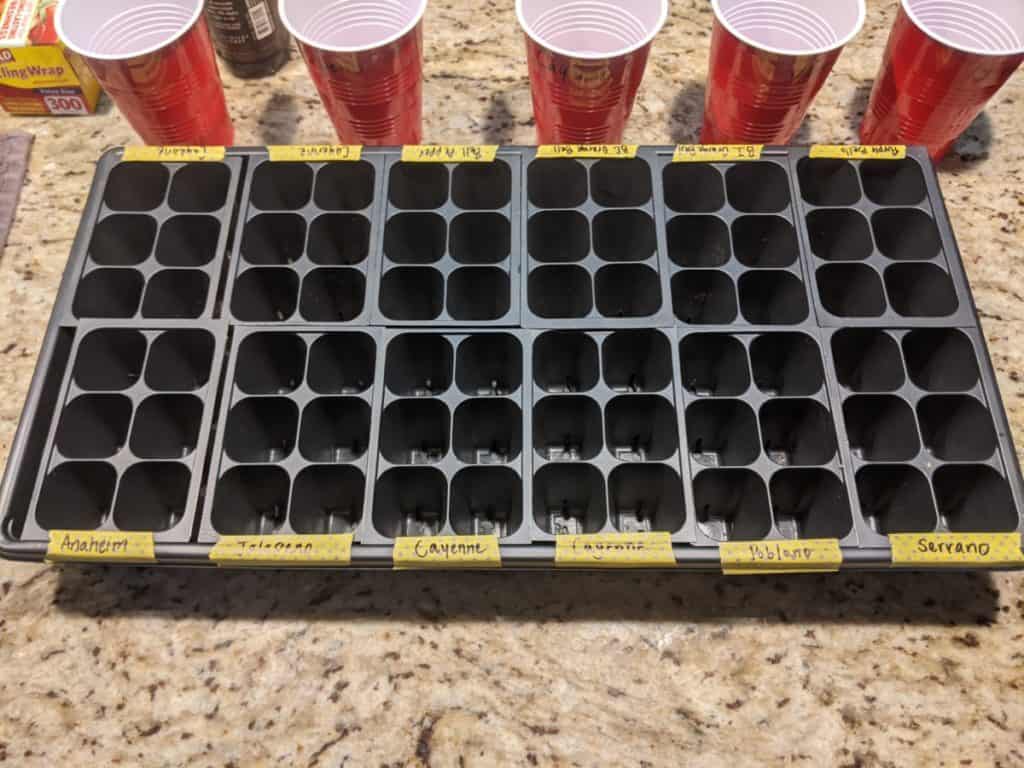
Step 2: Layout your Seed Trays and Put the Cell Packs in Them
Set our your seed trays and put your cell packs on top of them. The seed trays will hold the excess water from the cell packs, so you don’t have water leaking out all over the place.
Step 3: Boil Water To Moisten Seed Starting Mix
I pour boiling water over the seed starting mix to kill fungus gnat eggs. These little gnats will start to appear once your seedlings start to grow. These fungus gnats feed on plant roots and soil material. They are not only annoying but can kill some of your weaker seedlings as well.
If you forget to do this or just don’t want to mess with boiling water. Your seedlings will be fine most of the time regardless. You do have to moisten the soil or your seeds will not germinate.
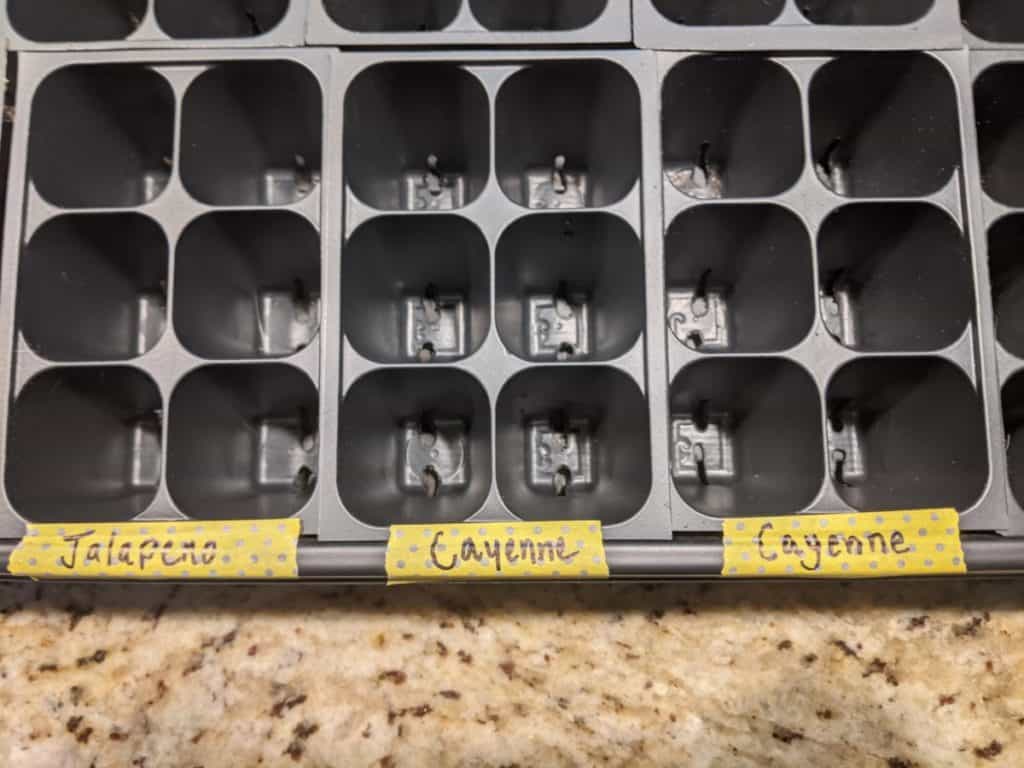
Step 4: Label Your Seed Cell Packs Or Containers
Label each cell pack. You can use stickers, masking tape, plant stakes, or something else. Trust me if you don’t label your pepper plants you will be planting mystery peppers in your garden.
I label all my plants with a sharpie marker and masking tape. I still seem to end up with a few plants that have lost their labels every year it seems.
Step 5: Place Soil Mix into Cell Packs/Pots
Once your soil is moist put it into the cell packs, pots, or containers you are using. Fill the cell packs with soil up to the top of each cell.
Whatever container you use make sure it has drainage holes for the excess water to escape. I prefer using 4-pack and 6-pack plastic cell containers.
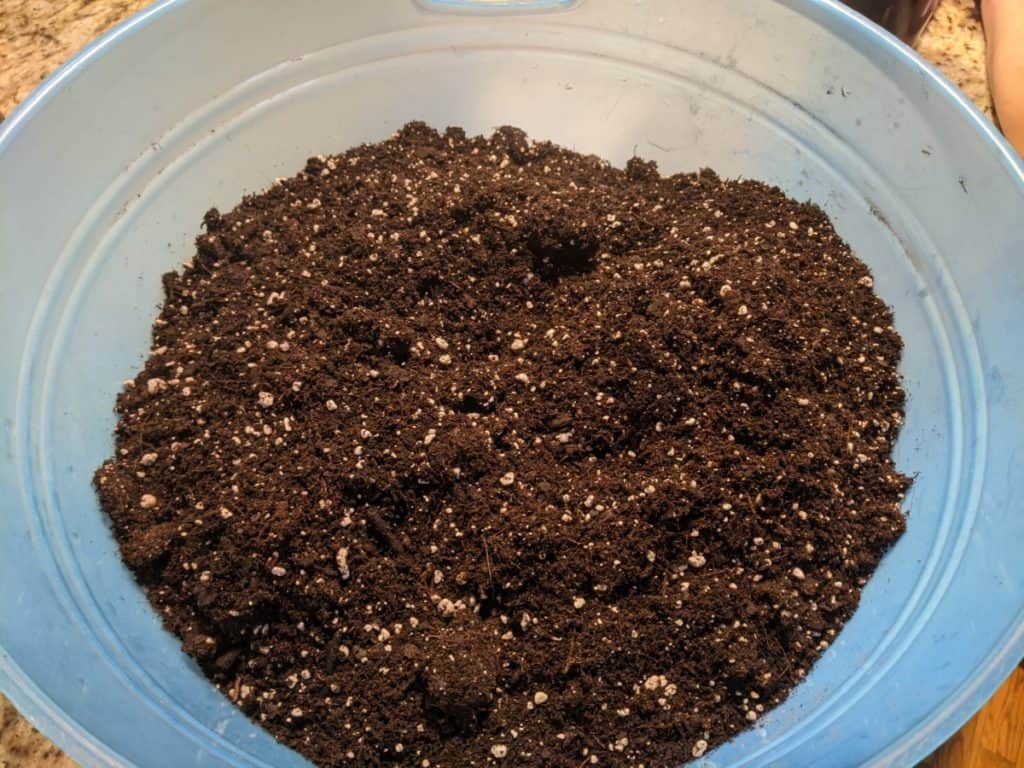
Step 6: Plant Your Pepper Seeds In the Soil
I generally put 2 or 3 seeds in each cell. I do this in case some seeds don’t germinate. If you have purchased an expensive exotic pepper seed then you may want to just use one seed per cell for these.
If I have excess seedlings that germinate in one cell I sometimes replant them in new cells. If I have enough seedlings I just toss extras into the compost pile.
You don’t want to plant your seeds too deep in the soil. The general rule is to plant seeds at a depth equal to two or three times their width. It is better to plant seeds too shallow than too deep.
I use a pen or pencil and make a little hole to drop the seeds in. After you put the seeds into the soil gently cover them up.
Step 7: Lightly Water Seeds More If Necessary
Your soil mix should be very moist from pouring boiling water over the soil to kill fungus gnat eggs. However, if your soil mix is dry in some places you can use a plastic sprayer or water bottle to moisten the soil further.
You do not want to soak the seeds and disturb the soil. This is because you could expose the seeds to light by dumping water on them and moving the soil.
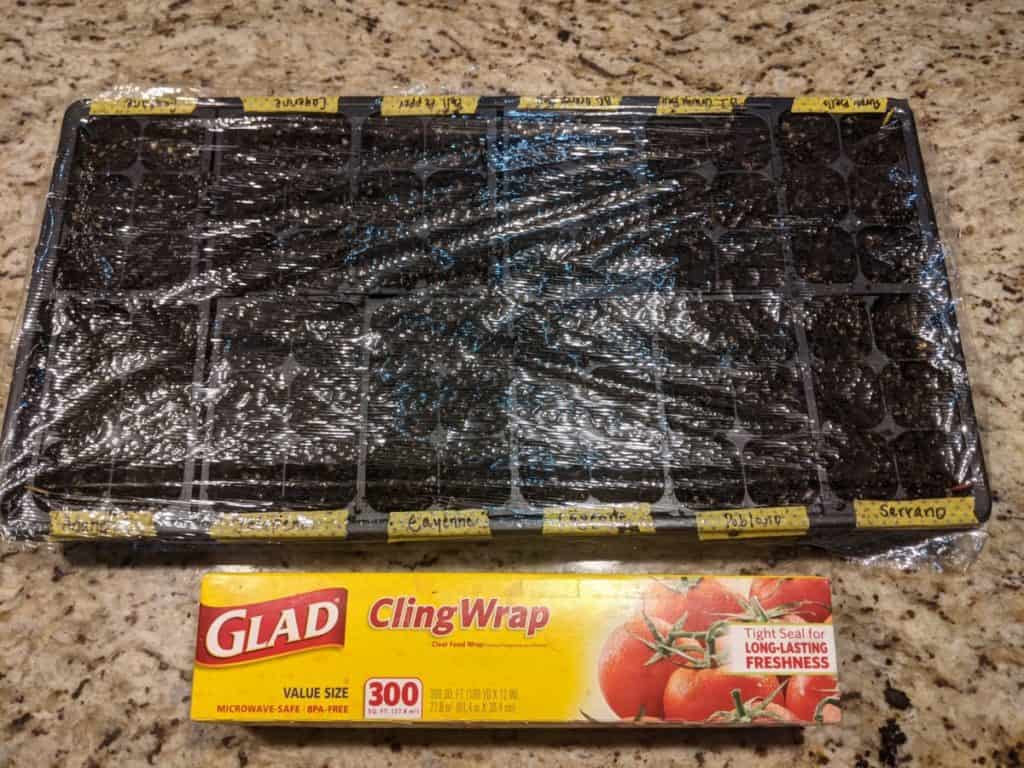
Step 8: Place Plastic Cover Over Seeds For Germination
You can use a clear plastic cover such as a bag, or saran wrap. I place a saran wrap over my peppers and put them on a shelf in my basement.
It usually takes about one week for the seeds to start sprouting. However, that can vary depending on the temperature of the room and soil.
Step 9: Place Seed Trays On Seed Heating Mat (Not Required)
Pepper seeds like soil in the 85-degree Fahrenheit range. If you are growing more exotic types of peppers such as a Carolina Reapers, Trinidad Scorpions, or other peppers a seed heating mat could be necessary.
Many of the hotter pepper types have fickle germination rates. So to be on the safe side use a heating mat for them.
I have tried growing some of these hotter exotic peppers without a heating mat and was not always successful. If you purchase these types of seeds online they should tell you if you need a heating mat or not for germination.
However, if you have a heating mat use it. Peppers will always germinate better with one if available.
Peppers such as Jalapoens, Cayenne, Anaheim, Serrano, Pablano, Bell Peppers, and others do not require a heating mat to germinate effectively.
At least they don’t in Georgia. I am able to germinate these peppers in my heated basement each year.
Step 10: Monitor Your Seed Trays For Signs of Seedlings
Once you have seedlings starting to sprout you need to remove the plastic covering immediately. The seedlings need space and light to grow upwards.
Step 11: Turn on and Set Lighting for Seedlings to Grow
Once your seedlings have sprouted you need to set your lights on a timer. Seedings need 12-16 hours of light a day. You can set your lights using one of the many timers or smart plugs on the market today.
Your lighting needs to be close enough to the seedlings, so they can absorb the light efficiently. This will depend on if you are using Fluorescent Lights or LED Lights.
Fluorescent lights should be about 2 to 4 inches above your seedlings. If you are using LED lights they need to be 8 to 10 inches away.
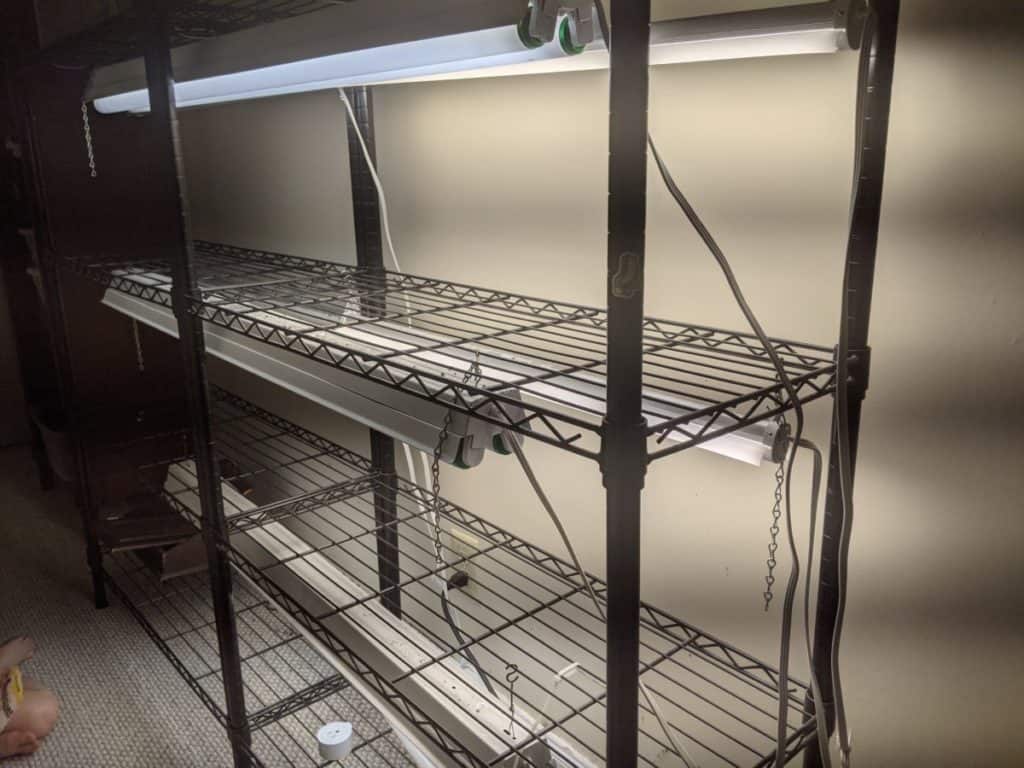
What Kind of Light Do I Need To Start Seeds Indoors?
Not all light bulbs work well for starting seeds indoors. You want a minimum of 5000k for light color and at least 2100 lumens for light intensity. The best lights have 6500k for light color and 3000 lumens or higher for light intensity.
You can buy cheap fluorescent shop lights at Home Depot or Lowes. Look for the lumens and light color on the side of the box.
If you don’t mind spending more money the LED grow lights are a superior option to start seeds, but they are not necessary. I have personally used cheap shop lights purchased from Home Depot for years and years and I get great plants every year.
When Should I Start Pepper Seeds Indoors
Start sowing pepper seeds indoors a minimum six weeks before the last frost in your area. I start my pepper seeds 10-12 weeks before the last frost in my zone. This gives the plants 2 weeks to germinate and 2 months to grow before planting in the garden outside.
Do I need to Soak Pepper Seeds Before Planting?
Yes, you need to soak pepper seeds for at least 2 to 12 hours before planting them in containers. This signals to the seed that it is time to grow. If you do not soak your pepper seeds you will have problems with germination.
What Is The Best Soil to Start Pepper Seeds In?
When starting from seeds, make sure to use high-quality peat-based potting soil formulated specifically for seed starting.
Do not reuse old potting soil or mix it with any other type of dirt. This reuse can ruin the quality of your future plants. This is because the soil could contain insect eggs, disease, or other problems you can’t see.
If you can’t find a good start seed mix easily a good potting soil formulated for vegetable plants should work without too many issues.
How Deep Do You Plant Pepper Seeds?
The general rule is to plant seeds at a depth equal to two or three times their width. I usually just use a pen or pencil to round out a tiny hole and drop 2 or 3 seeds in.
It is better to make the hole too shallow rather than too deep. This is because the seed only has a tiny amount of energy. If you plant it too deep it will not be able to grow enough to pierce the top of the soil.
When Should You Start Germinating Pepper Seeds?
It should take about 7-21 days for pepper seeds to germinate. Hotter exotic peppers take longer to germinate than a common peppers such as a Serrano that has less heat.
Once you have put the pepper seeds in containers with soil and put plastic wrap over them it’s time to let them germinate.
Do Pepper Seeds Need Darkness To Germinate?
When you plant pepper seeds, keep in mind that they can grow in light or dark conditions. However, they need to be exposed to the correct temperature for optimal growth.
Do Pepper Seeds Need Light to Germinate?
Pepper seeds do not need light to germinate. After three or four days you should turn on your grow lights. So when your seedlings first emerge they will immediately get hit with light for an optimal growth curve.
How Long does it Take for Pepper Seeds to Germinate Indoors?
It takes about one to three weeks for pepper seeds to sprout indoors if the temperatures in the 70-80 degrees F range. The hotter the pepper the longer the germination takes.
How Often Should I Water Pepper Seeds?
If the tops of the seed-soil cells are starting to dry out you should water cell packs. Pour water in the bottom of the seed trays. The soil and later the seedlings will slowly soak up the water.
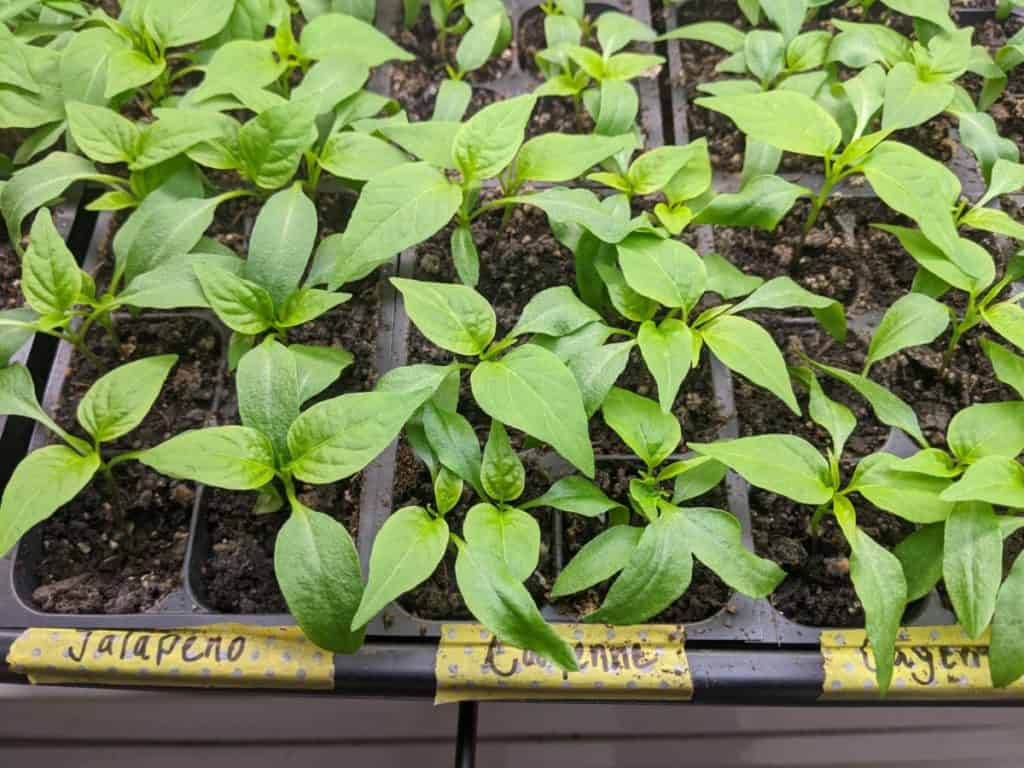
How Many Times a Day Should I Water Pepper Seedlings?
You want your pepper seedlings to be moist but not wet. You should water them once a day or every other day as necessary. Do not let them dry out. You can also use a spray bottle to keep them moist.
I usually always pour water into the bottom of my seed trays. This allows the seedling roots to soak up the water through the bottom of the soil.
How Much Light Do Pepper Seedlings Need?
Pepper seedlings need a minimum of 12 hours a day of light. 16 to 18 hours of light per day is recommended mount for optimal pepper seedling growth.
Can I Grow Peppers in a Windowsill?
Peppers will not get enough light growing in a windowsill or a kitchen table with natural light coming in. Your pepper plants will become leggy and fall over due to lack of light. I know this because I have tried in the past many years ago when I first started growing plants from seeds.
The best way to avoid this is to invest in an artificial light system that you can use every year. This system will help start your pepper seeds and other vegetables indoors.
Do I Need to Transplant My Peppers From 4 Packs or 6 Packs?
If you are using large 4 pack containers your peppers should be ok until you plant them outside in your garden.
If you are using the small 6-pack containers you are probably going to have to transfer them to a 4-pack container as they grow.
A better option would be a larger individual pot found here on Amazon.
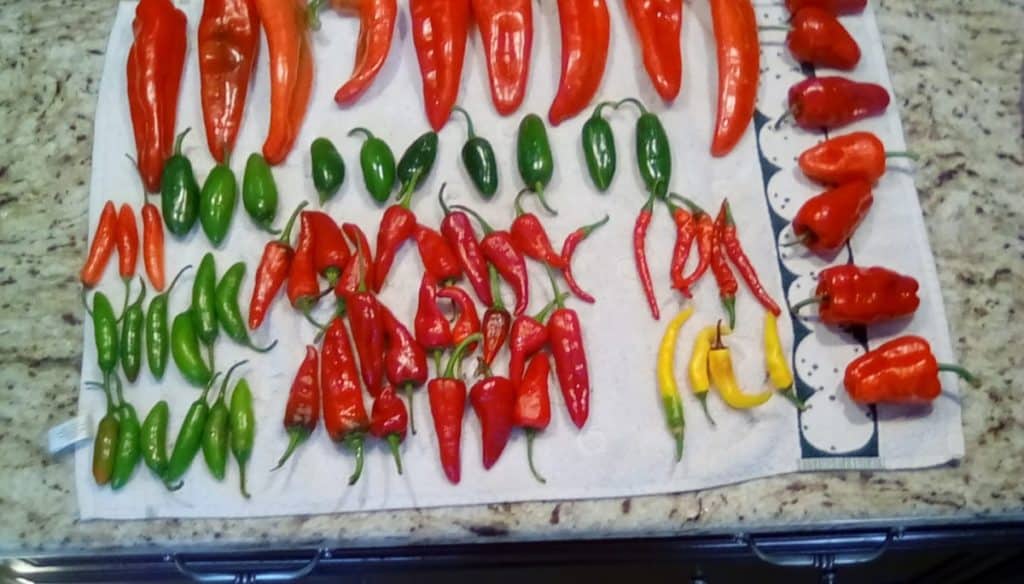
Do Pepper Plants Need to be Hardened off?
Yes, pepper plants must be hardened off before planting them directly outside in your garden. Your peppers will need to have their true leaves and have grown 3 or 4 inches before putting them outside. If you started them 6 weeks or earlier before the last frost then they will be ready to harden off.
To harden my pepper plants I put them outdoors in a shady area to start.
I then put them outside for a couple of hours each day for 7 to 10 days. Each day I put them in a spot with a little more light. After 7 to 10 days they should be fully hardened off and ready to plant.
Do not put your small plants in direct sunlight for hours on end they will burn, wilt and die! I know from experience. I lost a lot of peppers and tomatoes my first year trying to harden off plants. It was not a pretty sight believe me.

